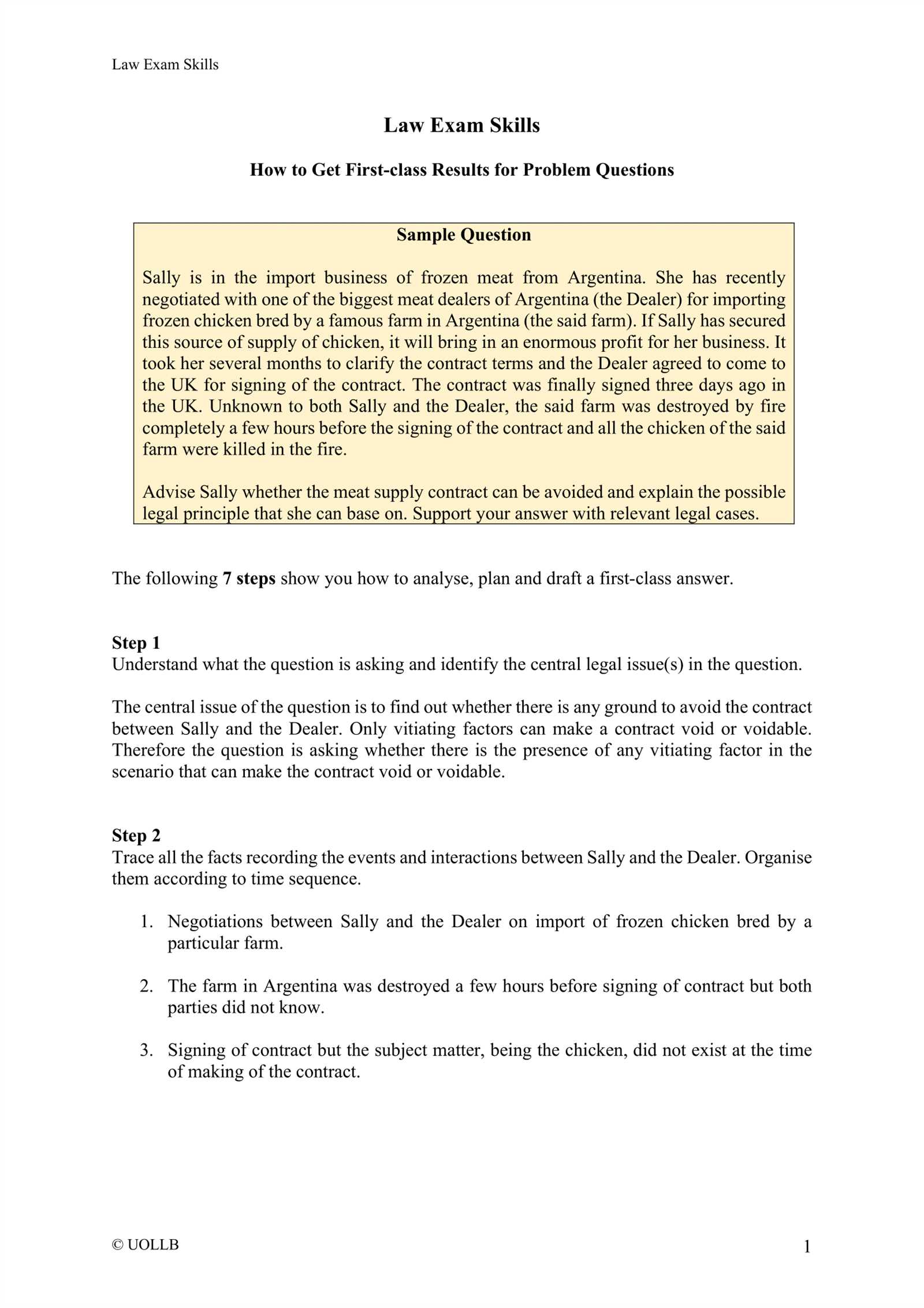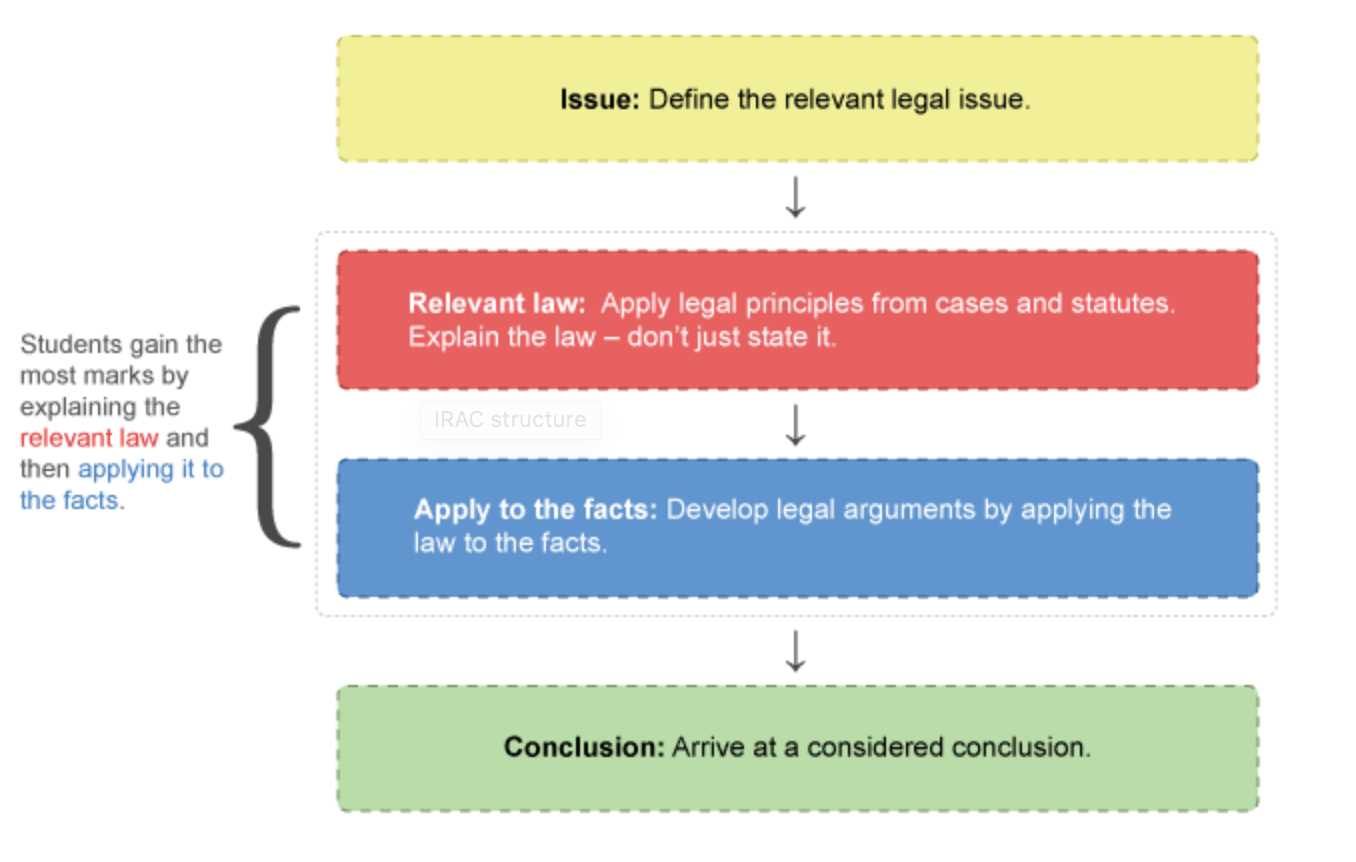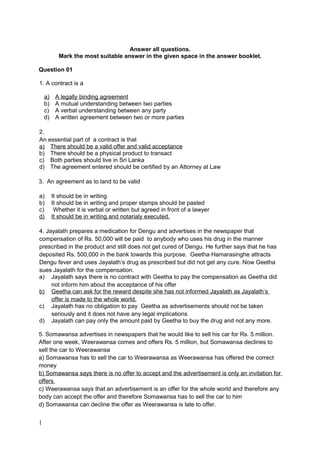
Success in assessments requires more than just knowledge of the subject matter. It demands the ability to express critical thinking clearly, concisely, and persuasively within the time constraints. The key to mastering this skill lies in understanding the structure of the task, applying relevant concepts, and presenting your thoughts in an organized and logical manner.
To excel, it is essential to focus on how to break down each part of the problem, identify the core issues, and construct a well-supported response. The ability to effectively analyze the scenario and articulate your reasoning will set you apart from others. With the right approach, even the most complex challenges can be tackled with confidence.
Strategic preparation is crucial, as is a deep understanding of the principles that govern the subject. Once you master the techniques for structuring your responses, your performance will greatly improve, leading to stronger results and increased success in future assessments.
How to Approach Complex Assessment Prompts
Successfully tackling challenging academic tasks requires more than just recalling memorized material. It involves interpreting the problem at hand, identifying key points, and constructing a logical, well-structured response. Focusing on clarity, precision, and relevance is essential to convey your understanding effectively.
Identifying Core Issues
Start by carefully analyzing the prompt to uncover the central issues that need to be addressed. Look for any terms or phrases that point toward the essential topics. This step helps prioritize your focus, ensuring that you concentrate on the most important aspects rather than getting distracted by unnecessary details.
Building a Logical Structure
Once you’ve identified the main points, organize your thoughts in a way that clearly communicates your reasoning. Begin with an introduction outlining your approach, followed by a detailed analysis of each issue. Conclude with a summary of your findings or a clear position based on the analysis. This structure will help guide the reader through your thought process and demonstrate your ability to present a coherent argument.
Understanding the Exam Structure
To effectively tackle any academic challenge, it is crucial to grasp the overall structure and expectations of the task. Knowing how the material is presented and what is being assessed allows you to tailor your approach, ensuring that you address each aspect appropriately.
The layout of most assessments follows a common pattern. Familiarizing yourself with this format will help you navigate the prompt more easily and manage your time efficiently. Here’s a breakdown of the typical structure you can expect:
- Introduction: Often, a brief overview of the scenario or context is provided to set the stage for the task at hand.
- Problem or Issues: The core components of the task will be presented, detailing the key areas that need to be addressed. Look for legal principles, facts, or conflicts that must be analyzed.
- Analysis Section: This part of the task will require a thorough examination of the issues, where applying relevant knowledge and demonstrating critical thinking is essential.
- Conclusion: In most cases, a well-defined resolution or final position is required. Be sure to support your conclusions with the evidence and arguments presented earlier in the response.
Understanding these components will help you structure your response in a way that meets the examiner’s expectations and allows for a comprehensive, organized presentation of your thoughts.
Key Principles of Legal Analysis

At the heart of any academic task lies the ability to critically assess and interpret the information presented. The process involves identifying key concepts, applying relevant frameworks, and reasoning through complex scenarios. By mastering these principles, you can create well-reasoned arguments and responses that effectively address the prompt.
When analyzing a given situation, it’s essential to consider several core principles that guide the assessment process. These principles help structure your response and ensure that you address the most important elements clearly and effectively. Below is an overview of these guiding principles:
| Principle | Description |
|---|---|
| Issue Identification | Recognize and outline the main issues that need to be addressed. This is the first step in formulating an effective response. |
| Application of Frameworks | Apply relevant frameworks, such as rules, precedents, or legal tests, to analyze the situation in depth. |
| Critical Reasoning | Assess all sides of the argument, considering different perspectives and evaluating the strengths and weaknesses of each. |
| Clarity and Precision | Present your analysis in a clear, organized manner, avoiding unnecessary complexity or ambiguity. |
By adhering to these principles, you can develop a thorough and well-supported analysis, ensuring that your response is not only comprehensive but also persuasive and logically sound.
Breaking Down the Question Prompt

Before jumping into the response, it’s crucial to thoroughly understand the task at hand. This involves carefully examining the prompt to identify what is being asked and how to address it effectively. Breaking down the prompt into smaller, manageable parts will guide your approach and ensure that no key element is overlooked.
Identifying Key Components
To begin, dissect the prompt to uncover the core elements. These components often include:
- Facts or Scenario: What are the details provided? Understand the context and background information.
- Legal Issues: What are the central matters that require examination? Focus on the critical aspects of the task.
- Instructions: What specific directions are given? Pay attention to any requirements regarding format, structure, or the depth of analysis needed.
- Time Constraints: Are there any time limits or expectations regarding the length or depth of the response?
Clarifying the Task’s Purpose
Once you’ve identified the individual parts, think about the overall goal of the task. Is it to provide a detailed analysis, suggest a solution, or make an argument? Understanding the underlying purpose will help you shape your response in a way that meets expectations. Focus on addressing each part of the prompt systematically and logically.
How to Identify Legal Issues

Recognizing the key challenges within a scenario is essential for constructing a focused and well-supported response. This involves understanding the core elements that need attention and applying relevant knowledge to pinpoint the underlying matters. By identifying these key areas, you can ensure that your analysis is both targeted and comprehensive.
When reviewing a prompt, look for specific indicators that suggest which issues need to be examined. These may include:
- Conflicts or Disagreements: Identify any conflicts or opposing viewpoints that require clarification or resolution.
- Ambiguous Terms: Watch for terms that may be unclear or open to interpretation, as these often highlight issues that need to be defined or explained.
- Relevant Facts: Focus on facts that are significant to the task at hand. Any facts that seem to have legal consequences should be examined closely.
- Implications or Consequences: Consider the potential legal implications of the facts presented, as these often lead to specific legal issues that must be addressed.
By carefully analyzing these indicators, you can ensure that you are addressing the right issues and providing a thorough and focused response.
Organizing Your Answer Clearly
A well-structured response is essential for presenting your ideas effectively. Clear organization not only makes your argument easier to follow but also helps ensure that all key points are addressed systematically. Proper organization allows the reader to understand your reasoning step by step, providing a logical flow that guides them through your analysis.
To create a clear structure, consider the following tips:
- Start with a clear introduction: Briefly introduce the main points and set the stage for your analysis.
- Use headings and subheadings: Break down your response into sections with descriptive headings to guide the reader through the content.
- Present a logical flow: Ensure that each paragraph builds upon the previous one. Avoid jumping between unrelated ideas.
- Conclude effectively: Summarize your main points and restate any conclusions drawn from your analysis in a concise manner.
By organizing your response in a clear, structured manner, you increase its readability and effectiveness, making it easier for the reader to follow your reasoning and understand your conclusions.
Using Relevant Legal Precedents
Incorporating previous rulings or established case law is a vital part of any thorough analysis. Referencing pertinent examples from the past helps to support your position and strengthens your argument. This approach demonstrates a clear understanding of how past decisions influence current matters and shows the logical consistency of your reasoning.
Identifying the Right Precedents
When selecting precedents to include in your response, focus on cases that closely resemble the scenario you are analyzing. Ensure that the precedents are applicable to the issues at hand and that they have similar facts or legal principles. This will enhance the relevance of your argument.
Integrating Precedents into Your Argument
Once relevant precedents are identified, integrate them into your response by drawing clear comparisons. Highlight key points from the case law that align with the current situation, and explain how the principles from these past decisions support your analysis. Be sure to address both the facts and the legal reasoning behind each precedent to provide a comprehensive understanding.
Building a Logical Argument
Constructing a coherent and sound argument is essential for persuading the reader and demonstrating your understanding of the issue at hand. A logical structure ensures that your points are clearly connected and follow a reasonable progression. By systematically presenting your reasoning and supporting it with evidence, you create a compelling argument that is easy to follow and well-founded.
Key Components of a Logical Argument
To build a strong argument, focus on the following key components:
- Clear Thesis Statement: Begin with a clear and concise position that summarizes your argument in one sentence.
- Evidence and Support: Provide facts, precedents, and examples that substantiate your thesis. These elements strengthen your position and lend credibility to your reasoning.
- Counterarguments: Address potential opposing viewpoints and explain why your argument still holds. This shows critical thinking and strengthens your position.
- Conclusion: End by summarizing your argument, reaffirming your position, and emphasizing the strength of your evidence.
Ensuring Consistency and Clarity
As you develop your argument, it is important to maintain consistency. Each point should naturally flow from the one before it, without contradictions. Clear language and logical sequencing will ensure that your reasoning is easy to understand. Avoid unnecessary complexity, and make sure each step in your argument supports the central thesis effectively.
Effective Time Management Strategies
Maximizing your available time during a challenging task requires careful planning and efficient execution. By employing effective time management techniques, you can allocate sufficient time to each part of the task, minimize stress, and ensure that your response is well-crafted. Proper time allocation allows you to focus on important details without rushing through critical steps.
Prioritizing Tasks
Begin by identifying the most important elements that require attention. Break the task down into manageable parts and allocate time based on their significance. Consider which sections will take the most time and which need more thought. Focusing on key aspects first ensures that you give the most important issues the attention they deserve.
Setting Time Limits
Set a specific time limit for each section of your work. For instance, allocate 10-15 minutes for planning your approach and identifying key points, then stick to a set time for drafting each part of your response. By managing your time efficiently, you reduce the risk of spending too much time on one part and leaving insufficient time for others.
Applying Relevant Rules Effectively
When addressing complex problems, it is essential to accurately incorporate the appropriate principles that govern the situation. Recognizing these rules and using them in the right context strengthens your argument and allows you to provide a structured and sound solution. Each rule should be considered in relation to the facts at hand, ensuring the application is both logical and precise.
To apply these principles effectively, start by thoroughly understanding the key elements of each rule. Then, assess how these elements interact with the details of the situation you are analyzing. Clearly demonstrate the connection between the rule and the facts, ensuring that the application is supported by reasoning and analysis.
Handling Hypothetical Scenarios
Dealing with hypothetical situations requires a clear understanding of the principles that apply to such cases. These scenarios often present an altered set of facts, requiring you to reason logically and apply relevant rules to arrive at a solution. The key is to break down the scenario into its components, analyzing each one individually before drawing a conclusion.
Step-by-Step Approach
Start by identifying the key facts within the hypothetical scenario. Next, assess how these facts interact with established principles. It’s important to analyze the facts critically and determine whether they lead to different outcomes based on the rules at your disposal. Always remain objective and ensure your reasoning aligns with the facts provided.
Balancing Assumptions and Evidence
While working with hypothetical scenarios, you must balance making reasonable assumptions with staying grounded in the evidence. Base your conclusions on the facts that are given and avoid introducing speculative elements. A well-reasoned approach demonstrates your ability to navigate complex situations and apply the correct framework logically.
Avoiding Common Exam Pitfalls
When tackling assessments, there are several common mistakes that can hinder performance. Being aware of these potential errors and taking steps to avoid them will help you approach your responses with greater precision and clarity. Recognizing pitfalls early allows for better preparation and more focused work during the task.
Key Mistakes to Avoid
- Failure to Address All Parts: Ensure that you cover every element of the prompt. Often, students overlook certain aspects, which leads to incomplete answers.
- Overloading with Irrelevant Information: Stick to the most relevant details. Adding unnecessary information can dilute the strength of your response and confuse the main point.
- Misunderstanding the Question: It’s crucial to fully comprehend the prompt before diving into your response. Misinterpreting what is being asked can lead to wasted time and incorrect analysis.
- Weak Structure: A disorganized response can make it difficult to follow your reasoning. Always ensure your work is logically structured, with clear arguments and a cohesive flow.
Strategies for Avoidance
- Plan Before You Write: Take a moment to outline your approach. This helps to stay on track and ensures all parts of the task are addressed in an organized manner.
- Stick to the Facts: Focus on the essential facts and rules relevant to the scenario. Avoid veering off into speculative or irrelevant discussions.
- Review Your Work: Before submitting, quickly review your response to check for any overlooked elements, misinterpretations, or unclear sections.
Avoiding Irrelevant Information
Including only relevant details is crucial for a focused and concise response. When addressing a topic, it’s easy to stray from the core issue and include unnecessary points that don’t directly contribute to your analysis. By carefully selecting the most pertinent facts and rules, you can ensure your response remains clear, logical, and impactful.
Recognizing What Is Not Relevant
- Irrelevant Background: Avoid providing excessive historical context or background information unless it directly contributes to understanding the current situation.
- Off-Topic Details: Stick to the facts and rules that are directly related to the scenario. Including peripheral details may distract from the main argument.
- Speculation: Refrain from making assumptions or offering speculative arguments that are not supported by the provided information or established rules.
- Unnecessary Personal Opinions: Focus on objective analysis and avoid inserting personal views unless they directly enhance the reasoning process.
Effective Strategies for Staying on Track
- Understand the Core Issue: Carefully analyze the prompt to identify the specific aspects that need addressing, ensuring your response stays focused on the key issues.
- Plan Before You Write: Create an outline to organize your thoughts and ensure that each point you make directly contributes to answering the prompt.
- Constantly Refer Back to the Prompt: Throughout your response, regularly check if the points you are making are directly relevant to the task at hand.
- Review for Relevance: After drafting your response, review it to eliminate any information that does not directly support your main argument or analysis.
Preparing for Different Question Types
In any evaluation, you will encounter different types of inquiries that require tailored approaches. Each format demands a specific method of preparation and response. Understanding these variations helps to structure your thoughts more efficiently and respond in a way that is both relevant and precise.
Types of Question Formats

| Type of Question | Approach | Focus Area |
|---|---|---|
| Problem-Based | Identify facts, apply relevant rules, and analyze the scenario. | Practical application of principles to specific facts. |
| Theory-Based | Present and explain the theoretical concepts behind the topic. | Fundamental principles, definitions, and frameworks. |
| Essay-Style | Provide a well-structured argument with introduction, body, and conclusion. | Comprehensive discussion with supporting evidence and counterarguments. |
Strategies for Effective Preparation
- Understand the Format: Familiarize yourself with different types of prompts to know what is being asked. This awareness allows for a more organized response tailored to each format.
- Practice Time Management: Allocate sufficient time to address each type of prompt based on its complexity. Time yourself while practicing to enhance your efficiency.
- Review Key Concepts: Make sure you have a strong grasp of foundational principles that apply across various question types. This will allow you to quickly apply them in different contexts.
- Analyze Past Examples: Examine past responses to similar inquiries to understand the expectations and techniques used in addressing different formats.
Tips for Writing Under Pressure
When faced with time constraints, maintaining clarity and focus is essential. Pressure can often lead to stress, which may hinder your ability to structure thoughts coherently. By developing strategies to stay calm and organized, you can improve the quality of your responses, even under tight deadlines.
Effective Techniques for Managing Stress
- Stay Calm: Take a few deep breaths and center yourself. Anxiety can cloud your thinking, so maintaining composure is key to producing your best work.
- Read the Prompt Carefully: Skim through the instructions at least once to ensure you understand what is being asked before you begin writing. A clear understanding of the task prevents wasting time on irrelevant points.
- Break the Task Into Sections: Dividing your response into manageable parts allows you to focus on one element at a time, which helps with organizing thoughts quickly.
Time Management Techniques
- Set Time Limits for Each Section: Allocate specific time slots to each part of your response. This prevents spending too much time on one section and ensures that you address all parts of the task.
- Prioritize Key Points: Focus on the most important aspects first. If time runs short, ensure that your main arguments are well-supported and complete.
- Review Your Work: If time allows, quickly glance over your response to check for clarity and coherence. A brief review can make a significant difference in the overall quality of your submission.
Reviewing Your Answer Before Submission
Before finalizing any response, taking time to carefully evaluate your work can make a significant difference. A thorough review allows you to catch errors, ensure coherence, and refine your arguments. This step can be the difference between a satisfactory submission and an exceptional one.
Key Areas to Focus On During Review

| Area | What to Check |
|---|---|
| Clarity | Ensure that your points are clearly stated and easy to follow. Ambiguous or unclear phrasing can confuse the reader. |
| Structure | Check that your ideas are logically organized, with each part of your response building on the previous one. |
| Completeness | Verify that you have addressed all parts of the prompt. Skipping even small details can weaken your response. |
| Accuracy | Review your facts, references, or any specific data to make sure they are correct and relevant. |
| Grammar and Spelling | Check for typos, grammatical errors, and punctuation issues that might distract from the overall professionalism of your work. |
By systematically reviewing your work, you can ensure that your response is as strong and effective as possible before submission. It is always beneficial to approach this process with a critical eye, treating your work as if you were the reviewer, not the writer. This mindset often reveals overlooked errors or improvements that could enhance the quality of your final submission.
Improving Exam Performance Over Time
Continuous development of your skills is key to achieving better results with each session. Building upon past experiences and learning from each attempt can significantly enhance your performance in future assessments. This growth requires focus, reflection, and consistent practice to refine your techniques and strategies.
Strategies for Continuous Improvement
| Strategy | Benefits |
|---|---|
| Regular Practice | Consistent practice helps to identify weak areas, build confidence, and improve speed. Repetition ensures that concepts become familiar and easier to apply under pressure. |
| Seek Feedback | Feedback from instructors or peers provides valuable insights into your strengths and weaknesses. It allows you to correct mistakes and further develop your skills. |
| Self-Reflection | Reflecting on your past performances helps to pinpoint areas that need more attention. This personal evaluation guides future study efforts and enhances understanding. |
| Time Management | Improving time management skills ensures that you allocate sufficient time to each task. This reduces stress and increases efficiency during assessments. |
| Stay Updated | Keeping up with recent developments in the field ensures that your knowledge remains current. Staying informed about new techniques or changes can enhance your approach to problem-solving. |
By focusing on these strategies, you’ll be able to make incremental improvements, ensuring better outcomes over time. Every experience is an opportunity to refine your approach, helping you to achieve greater success in future assessments.